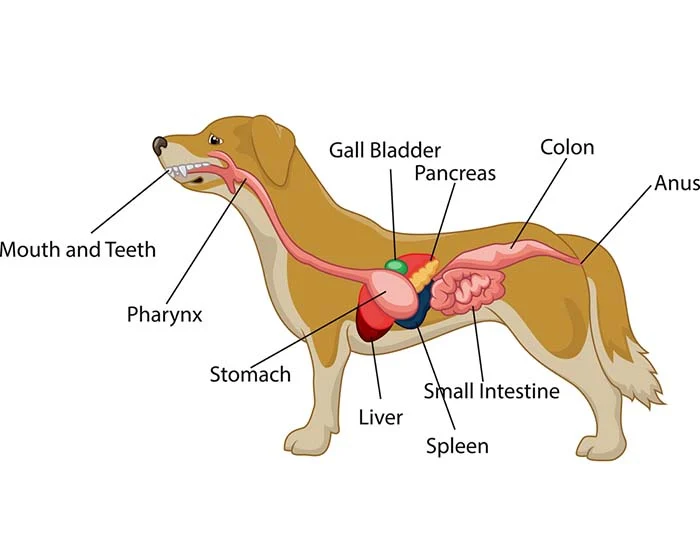Dogs have long held a special place in the hearts and homes of people worldwide, offering unwavering companionship and loyalty. As we welcome these furry friends into our families, it becomes imperative to comprehend the intricacies of their biological processes, particularly when it comes to nutrition and digestion. One crucial aspect that demands our attention is the duration it takes for a dog to digest food. This knowledge not only aids in tailoring a suitable diet but also plays a pivotal role in maintaining the overall health and well-being of our four-legged companions.
Man’s best friend possesses a unique digestive system that has evolved over centuries of domestication, adapting to both the human environment and the dietary choices provided by their human companions. Unlike humans, dogs are carnivorous scavengers by nature, with digestive processes finely tuned to extract maximum nutrition from a diet primarily composed of meat. Unraveling the mysteries of canine digestion requires a closer look at the journey food takes from the moment it enters their mouths to the eventual absorption of essential nutrients in their bodies.
The Digestive System of Dogs:
Mouth:
The culinary journey within a dog’s digestive system commences in the mouth. Equipped with sharp teeth designed for tearing and crushing, rather than grinding like those of humans, the mouth plays a pivotal role in the mechanical breakdown of food. Saliva, containing enzymes such as amylase, initiates the chemical digestion of carbohydrates. This initial phase prepares the ingested food for its onward passage through the digestive tract.
Stomach:
From the mouth, the partially chewed food travels down the esophagus and enters the stomach. The canine stomach is an acidic powerhouse, boasting a pH level ranging from 1 to 2. This extreme acidity serves multiple purposes: breaking down proteins into amino acids, initiating the digestion of fats, and acting as a formidable barrier against harmful bacteria that might be present in the ingested material. The stomach’s muscular contractions, along with digestive enzymes, further break down large food particles into a semi-liquid substance known as chyme.
Small Intestine:
Following its stint in the stomach, the partially digested food makes its way into the small intestine, a crucial site for nutrient absorption. Here, enzymes from the pancreas and bile from the liver continue the digestion process, breaking down proteins, fats, and carbohydrates into their fundamental building blocks. The absorptive walls of the small intestine then facilitate the passage of these nutrients into the bloodstream, providing the dog’s body with the essential elements necessary for overall health and vitality.
Large Intestine:
As the journey through the digestive tract progresses, any remaining undigested food, water, and electrolytes venture into the large intestine. In this final phase of digestion, water is reabsorbed, consolidating the formation of feces. The large intestine also houses a community of beneficial bacteria, which contribute to the fermentation of certain substances and aid in the extraction of additional nutrients. This microbial activity plays a vital role in maintaining the delicate balance of the canine digestive ecosystem.
Factors Influencing Digestion Time:
Size and Breed:
One of the foremost determinants of digestion time in dogs is their size and breed. Smaller breeds generally exhibit faster metabolisms and, consequently, quicker digestion rates compared to their larger counterparts. Additionally, individual breed characteristics can influence how efficiently a dog processes and absorbs nutrients from its diet. Recognizing these variations is essential for tailoring a diet that aligns with the unique needs of different breeds.
Age:
Age is a pivotal factor affecting digestion in dogs. Puppies, in the early stages of development, typically experience faster digestion rates compared to adult dogs. As dogs mature, their metabolism tends to slow down, leading to changes in digestion speed. Aging dogs may require adjustments to their diet to accommodate these shifts and ensure they receive the necessary nutrients for sustained health.
Type of Food:
The composition of a dog’s diet significantly impacts digestion time. Dogs fed commercial processed dog food may experience quicker digestion than those on a homemade raw diet. Processed foods are often formulated for easy digestion and nutrient absorption. On the other hand, a raw or home-cooked diet may require more effort from the digestive system to break down and assimilate the nutrients, potentially leading to longer digestion times.
Individual Health:
The overall health of a dog plays a pivotal role in its digestion process. Dogs with pre-existing gastrointestinal issues or chronic conditions may experience variations in digestion time. Conditions such as inflammatory bowel disease, food allergies, or malabsorption disorders can affect the efficiency of nutrient absorption and the overall digestive process. Maintaining a close eye on a dog’s health and promptly addressing any digestive concerns is crucial for their well-being.
Hydration Levels:
Adequate hydration is essential for proper digestion. Dogs that have access to fresh water and remain well-hydrated generally experience more efficient digestion. Water is crucial in the breakdown of food particles, the absorption of nutrients, and the formation of feces. Dehydration can lead to constipation and potentially impact digestion time.
Activity Level:
The level of physical activity a dog engages in can influence its digestion. Regular exercise promotes a healthy metabolism, which can contribute to more efficient digestion. Dogs with sedentary lifestyles may experience slower digestion rates, while active dogs might process food more swiftly.
General Timeline:
The journey of food through a dog’s digestive system follows a general timeline, although individual variations exist based on factors such as size, age, and diet. Understanding this timeline provides insight into the efficiency and adaptability of a dog’s digestive processes:
Mouth (0-5 minutes):
The digestive journey commences as a dog begins chewing food in the mouth. Mechanical breakdown and initial chemical digestion take place, primarily focused on breaking down carbohydrates with the help of salivary enzymes.
Stomach (2-6 hours):
From the mouth, the partially digested food travels down the esophagus and enters the acidic environment of the stomach. Here, proteins are broken down into amino acids, fats undergo initial digestion, and the overall composition is transformed into a semi-liquid substance known as chyme. The stomach’s muscular contractions aid in further mechanical breakdown.
Small Intestine (4-6 hours):
The partially digested chyme moves into the small intestine, where the bulk of nutrient absorption occurs. Enzymes from the pancreas and bile from the liver contribute to the breakdown of proteins, fats, and carbohydrates. Nutrients are absorbed through the walls of the small intestine and transported into the bloodstream for distribution to various body tissues.
Large Intestine (8-10 hours):
Any remaining undigested food, along with water and electrolytes, enters the large intestine. Here, water is reabsorbed, and the formation of feces takes place. Beneficial bacteria in the large intestine contribute to the fermentation of certain substances, extracting additional nutrients and aiding in the overall digestive process.
Elimination (10-24 hours):
- The final stage involves the elimination of waste. Feces move through the colon and rectum, and the dog expels the indigestible remnants of its meal. The timeline for elimination can vary, with factors such as individual metabolism, diet, and overall health influencing the speed at which waste is expelled.
Conclusion:
In unraveling the intricate process of canine digestion, we gain a deeper appreciation for the complexity of our loyal companions’ internal workings. From the initial crunch of kibble in their powerful jaws to the meticulous enzymatic processes within their stomachs and intestines, the journey of food through a dog’s digestive system is a marvel of biological engineering.
Understanding how long it takes for a dog to digest food is not merely an academic pursuit but a vital aspect of responsible pet ownership. As stewards of their well-being, it is our duty to comprehend the nuances of their digestive needs and tailor their diets accordingly. The digestive timeline, influenced by factors such as size, age, and diet composition, unveils the adaptability and resilience of the canine digestive system.
Our exploration into the mouth, stomach, small intestine, and large intestine underscores the orchestrated dance of enzymes, acids, and beneficial bacteria that transform ingested food into the energy and nutrients essential for a dog’s vitality. The factors influencing digestion time, ranging from breed characteristics to individual health and hydration levels, further emphasize the uniqueness of each canine digestive system.
In essence, this knowledge empowers pet owners to make informed decisions about their dog’s nutrition, allowing them to provide a diet that aligns with their furry companion’s specific needs. Regular veterinary consultations become instrumental in fine-tuning these dietary choices and addressing any concerns related to digestion or overall health.
As we conclude our exploration into the canine digestive system, we are reminded that the well-being of our four-legged friends is a holistic endeavor. Beyond the mechanics of digestion, it encompasses a commitment to regular exercise, mental stimulation, and a nurturing environment. By combining this understanding with attentive care and a tailored diet, we ensure that our dogs not only enjoy optimal digestion but also lead happy, healthy lives as cherished members of our families.
FAQs
Q1. How often should I feed my dog?
A1. Feeding frequency depends on factors such as age, size, and breed. Puppies often require more frequent meals (3-4 times a day), while adults may thrive on one or two meals daily. Consult your veterinarian for personalized feeding recommendations.
Q2. Can I change my dog’s diet abruptly?
A2. Abrupt diet changes can upset a dog’s stomach. It’s recommended to transition slowly over 7-10 days by mixing the new food with the old, gradually adjusting the ratios.
Q3. What human foods are toxic to dogs?
A3. Certain human foods, like chocolate, grapes, onions, and garlic, can be toxic to dogs. It’s crucial to avoid feeding these items and consult a veterinarian if accidental ingestion occurs.
Q4. How much water does my dog need?
A4. Adequate water intake is vital. Dogs generally need 1 ounce of water per pound of body weight daily. Factors such as activity level and climate can influence hydration needs.
Q5. Is it normal for my dog to eat grass?
A5. Occasional grass nibbling is often considered normal behavior for dogs. However, if it becomes excessive or is accompanied by vomiting, it’s advisable to consult with a veterinarian.
Q6. How can I prevent my dog from becoming overweight?
A6. Portion control, regular exercise, and choosing a balanced diet are key. Monitor your dog’s weight and adjust portions accordingly. Consult your vet for specific dietary recommendations based on your dog’s needs.
Q7. What should I do if my dog has food allergies?
A7. If you suspect food allergies, consult your veterinarian. They may recommend an elimination diet or allergy testing to identify and manage the specific allergens affecting your dog.
Q8. How can I improve my dog’s dental health?
A8. Regular tooth brushing, dental chews, and incorporating dental-friendly diets can help maintain your dog’s oral health. Consult your vet for advice on a dental care routine suitable for your dog.

Jane Doe, a veterinarian with over 10 years of experience, combines her deep knowledge of animal health with a passion for pet welfare at PetsPonder.com. With a DVM degree and a commitment to the latest in veterinary science, Jane Doe offers reliable, compassionate advice to help pet owners make informed decisions for their furry companions.

Leave a Reply